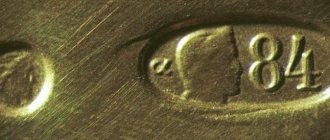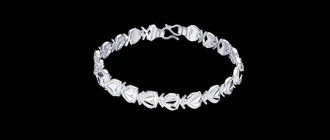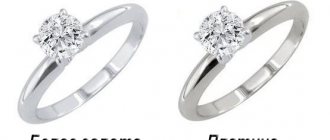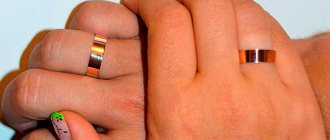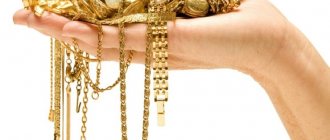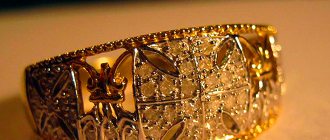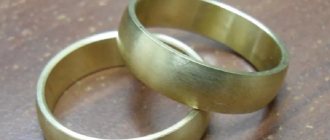Nowadays it is difficult to surprise anyone with a counterfeit product. Absolutely everything is counterfeited - from food to money, jewelry and works of art. And it is counterfeit jewelry that costs buyers the most. According to average statistical data, in Russian jewelry stores, imitation of the old precious metal - gold - already reaches half of the total number of products presented. And an imitation of an old gold product will definitely cost more than fake newfangled jewelry. How can you buy a real product made from old gold, and not a cheap alloy that looks like a noble metal?
Category “Investing in gold”
Today, counterfeiting jewelry is an extremely profitable business. After all, gold jewelry is small in size. They are convenient for smuggling. They have a high cost per unit volume and, moreover, their production does not require large premises and very complex technologies.
There are many ways to imitate gold.
The simplest is the so-called gypsy gold - copper polished to a golden shine. But usually different alloys are used. Sometimes these are very simple fakes made of brass, roundel, bronze, copper and even iron and aluminum. However, most often, to imitate gold, alloys are used that only an experienced jeweler or expert can distinguish from real gold.
Thus, the following counterfeits are often passed off as precious yellow metal:
7 aluminum bronze (aufir, aural, aufor) – a golden-yellow alloy (consists of 90 parts copper and 10 parts aluminum);
7 bathbronze (bathbronze) – an alloy of bronze and tin (used for gilding and casting of artistic and industrial products;
7 bathmetall – an alloy alloyed with zinc (used in England for the production of tableware);
7 vermeil (vermeil) – fire-gilded silver;
7 hamiltonmetall (hamiltonmetell) - an alloy of 66.7 parts copper and 33.3 parts zinc, golden yellow in color;
7 goldin (goldin) – an alloy of copper and aluminum (used in Germany for the manufacture of cheap jewelry);
7 durametall (durametall) – an alloy of copper, zinc and aluminum of golden-bronze color;
7 gold musiv - tin sulfide plastics with a golden luster (used for gilding; not corroded by sulfur and hydrogen sulfide, do not turn black);
7 Mannheim gold - an alloy of 83.6 parts copper, 9.4 parts zinc and 7 parts tin, painted gold;
7 mosaic gold - an alloy of 66 copper and 34 zinc (has a hint of native gold); oreide
7 “French gold” - a gold-colored alloy of 80 parts copper, 15 parts zinc and 5 parts tin;
7 pinchbeck, “English gold” - an alloy of copper and zinc (used for the manufacture of publicly available jewelry, costume jewelry, and frames); 7 similor - an alloy similar to gold (usually consisting of 83.7 parts copper, 9.3 parts zinc and 7 parts tin);
7 tombak - an alloy of copper and zinc of various compositions (usually 90 parts copper and 10 parts zinc) with a beautiful golden color;
7 electron – an alloy of gold and silver of various compounds;
7 “alloy of gold with titanium” - an alloy without gold (costume jewelry), but in color reminiscent of 585 gold (usually massive jewelry is made from it).
People are often sold on tombac, an alloy very similar to gold.
Selling tombak under the guise of gold is very popular in Turkey, where you can even “get” this alloy in a large store. Fake gold is often found in Israel, Italy, China, and the UAE. Pseudo-gold smuggling usually comes from these countries. Low-quality gold items break easily, but jewelers won’t repair them because... non-gold alloys cannot be soldered.
Recently, a lot of fake gold has appeared in Hong Kong and Vietnam (an alloy of gold with tungsten and other heavy metals).
Falsification is very common, when part of the product is made of real gold, and part is made of an alloy of copper, tin and zinc. For example, a lock on a gold chain with a stamp is indeed gold, but the rest of the part is made of a “gold-like” alloy.
Of course, genuine gold must have the appropriate hallmark. But, for example, in Turkey, the store will put the sample you want on the product right in front of you. It is clear that other jewelry can have any stamp.
Having been burned by fake yellow imported gold, Russians began to appreciate domestic red gold again. However, color today does not indicate the place of manufacture. Foreign importers, having studied the demand of Russian buyers, quickly switched to the production of red gold.
In order not to torment yourself with doubts and not to be disappointed with an expensive purchase, you should not buy gold second-hand or in dubious stores. It is better to go to large stores and purchase products from well-known Western companies and well-known Russian factories. Although the price of such gold will be higher, the likelihood of buying a fake will be relatively small.
It is worth remembering that according to official statistics, about 60% of gold items imported into Russia have a gold content significantly lower than the standard indicated on them, and more than half of the gold jewelry sold in Russia is fake.
If you have doubts about the authenticity of the gold, then you should take the product for examination, for example, to a pawnshop. If suspicions are confirmed, the fake gold jewelry can be returned to the same store where it was purchased.
Read also: How to make a knife sheath
The attitude towards imitation gold is twofold. On the one hand, this is still a fake, on the other hand, the appearance of the product or its content can be so noble that it more than compensates for the obvious lack of gold. This applies to the gilding of temple domes, coating of objects of art, and elements of exclusive furniture with materials similar to gold.
The history of counterfeits and legal substitutes for gold is so rich in facts that when asking the question: what is the name of a metal similar to gold, you can get an answer that will take more than a dozen pages. We will consider the most famous pseudo-gold alloys used in our time. So what material is similar to gold?
The first and most honest specimen will be Abyssinian gold. The presence of microscopic fractions of precious metal in the composition of the metal gives it some right to be called gold.
The main problem of any imitation is low corrosion resistance. Ethiopian jewelers, who were brilliant swindlers, or simply enterprising chemists, created an alloy similar to gold, which did not become covered with patina for a long time and could pass for gold in the eyes of even an experienced specialist. The new material was named after the old name of the country - Abyssinian. The basis of the alloy was copper, the content of which was almost 90%. The remaining parts were supplemented by zinc, and gold was added to corrosion resistance in very small doses - only 0.5%. This amount of precious metal was enough to make Abyssinian gold resistant to external influences.
Abyssinian gold is used to make “gold” metal crowns, in microelectronics and in jewelry.
This metal, similar to gold, is called, like its precious prototype, gold, with the prefix French. In this alloy, the original is completely absent and they are united only by color.
Another feature that reveals the imperfection of most fakes is the lack of the sparkling shine inherent in gold. However, talented chemists have created a metal alloy from copper, zinc and tin, which reproduces both the yellow-golden color and shine of precious gold. Its name among jewelers is Oraide or French gold. The percentage of components in this alloy is: 58% Cu, 25% Zn, 17% Sn.
French gold is used to make haberdashery, jewelry, and is used as a material to create art objects. On them you will not find a seal with the hallmark corresponding to gold products.
The brass-based alloy, known since the 17th century, looks like gold and behaves like gold. Tompak is slightly susceptible to corrosion and has a good shine; its color, like the color of gold, varies from yellow with red to light gold. The shades of the metal depend on the amount of copper, the usual content of which in the alloy is up to 90%. The amount of zinc is less than 10%. This metal, similar to gold, does not react to magnets.
Tompak has several additional names, among which the most common are similor, oreid and chrysorin.
The metal is used to make expensive furniture fittings, “gilded” decorative elements, dishes, interior items, insignia, sewing items, parts of wind musical instruments, coins and medals. In Russia, tombak is used as the basis for the main school award - the gold medal.
The combination of titanium with nitrogen gives rise to a special alloy - titanium nitride. This material, similar to gold, has truly unique characteristics. It is resistant to all types of atmospheric influences, does not react to hydrochloric and sulfuric acid, does not melt at temperatures up to 800 degrees, and does not lose its properties over time.
Thanks to these qualities, titanium nitride is used to imitate the effect of gilding church domes, interior decoration items, elements of exterior decoration of buildings and decorative metal structures.
Customers of large outdoor advertising projects, asking what metal is similar to gold, also receive an offer to coat their advertising installations with titanium nitride.
This beautiful and uniquely durable alloy is used to cover the surface of the cutting edges of medical instruments, tableware and decorative edged weapons.
By knowing that these imitations of gold are available, you are already protected as a buyer because you know that not everything is gold that looks like it. In order to learn how to distinguish fakes, we also recommend that you read our article on how to check gold for authenticity.
Nowadays it is difficult to surprise anyone with a counterfeit product. Absolutely everything is counterfeited - from food to money, jewelry and works of art. And it is counterfeit jewelry that costs buyers the most. According to average statistical data, in Russian jewelry stores, imitation of the old precious metal - gold - already reaches half of the total number of products presented. And an imitation of an old gold product will definitely cost more than fake newfangled jewelry. How can you buy a real product made from old gold, and not a cheap alloy that looks like a noble metal?
Read also: How to weld a cast iron pipe
Feng Shui Philosophy
The presence of magical properties in the pyrite stone was also discovered by residents of East Asia. They noticed that iron pyrite attracted money and good luck to the house. Therefore, the mineral has become a popular material for making all kinds of coins and figures that find their place in a residential apartment or office.
Typically, pyrite products are placed in places that accumulate negative energy, or in various special areas. They are distinguished as follows:
- The southeast indoors will be an excellent place for a mineral - a symbol of prosperity.
- At the entrance (hallway or corridor), the stone will serve as protection from dark forces and any negative energy.
In China, coins are made from pyrite. According to legend, carrying such a product in a bag or purse will have a positive effect on the financial well-being of the owner.
Iron pyrite is a very cheap and malleable mineral that is widely used in the production of a large number of other materials and products. Pyrite stone has strong energy, thanks to which it is able to influence a person. When buying jewelry with a gem, you need to remember both the positive, healing, and negative effects.
What alloys are similar to gold?
To understand how to distinguish a gold-like material from a real precious metal, you need to know which alloys can mimic the appearance of old gold. If you're unlucky, you can buy one of the following alloys:
- Aluminum bronze. It is a golden-yellow alloy. Perfectly imitates gold. Approximately 90% of this alloy is copper, the rest is aluminum.
- Butt bronze. It also has a beautiful golden yellow hue. Usually used for the manufacture of various artistic products. Unscrupulous sellers may pass it off as precious metal to gullible buyers.
- Batmetal. In some countries, tableware is made from it. This alloy imitates gold quite well.
- Belgium. This alloy is more similar to platinum. Includes iron, nickel and chromium. There is no hint of precious metal.
- Vermeil is silver processed by fire. During processing, the metal becomes similar to gold. But paying as much for silver as gold costs is not the best option.
- Hameltonmetal is an alloy of zinc and copper. It has a beautiful golden yellow hue. It is used for gilding of various products.
- Goldin. It is an alloy of aluminum and copper. In some countries, budget jewelry is made from it. Although the metal is beautiful, it has nothing in common with gold except its appearance.
- Durametal. This alloy consists of aluminum, copper and zinc. The ingredients are mixed in certain proportions and subjected to special processing. The final product has a beautiful golden-bronze hue. But again, this is not gold.
- Gold leaf. These very thin sheets are used for gilding a variety of wooden and metal products, as well as in other areas.
- Musiv is a sulfide tin with an attractive golden luster. Typically used for gilding. Its only advantage is that the material does not turn black over time.
- Mannheim gold. It is an alloy of zinc, copper and tin. It has a “gold” coloring.
- Mosaic gold. This alloy consists of zinc and copper. It has an original shade of native gold.
- False gold is an alloy of copper with a layer of precious metal.
- Oraide. This alloy consists of zinc, copper and tin. Sometimes iron is added. Used for casting inexpensive jewelry.
- Pinchbeck, which is an alloy of zinc and copper. Used for the production of budget jewelry. Passed off as gold by unscrupulous traders.
- Platinor is an alloy of silver, copper, nickel, zinc and platinum. The percentage of precious metals is so small that unscrupulous sellers stand to gain big by passing off such items as real gold.
- Similor. This alloy contains zinc, copper and tin. Usually the products are plated with gold.
- Tompak is one of the alloys most often passed off as gold. It contains zinc and copper. Has a beautiful shade. Thanks to copper it is resistant to corrosion.
- Electron. It contains silver and gold. In ancient times, the alloy was used to make coins.
Return to contents
Breed varieties
In nature, the mineral is found in several variations, each of which differs in color. After doing a chemical analysis, the researchers also noticed some differences between the species:
- Marcasite is a stone similar to silver, has a rich color and shines. It is considered one of the most beautiful species of the breed, therefore it often serves as a material for numerous decorations and crafts. An experienced jeweler can create a piece that will amaze even the most discerning jewelry lover. Why, since ancient times, representatives of the nobility actively showed off precisely such decorations.
- Bravoite differs from marcasite in a more saturated and “deep” shade of yellow. This is facilitated by the presence of the metal nickel in the rock composition (the content can reach 20%). The chemical formula of the varieties is the same, but the crystal lattice is still different.
The meaning of jewelry hallmark
It is important to consider that even the presence of a sample does not guarantee that you are buying a precious metal. If with Russian markings the buyer is still a little clear (usually these are numbers next to a female profile or a star and a hammer and sickle), then with samples according to foreign standards everything is much more complicated.
And the knowledge that 14-karat gold corresponds to the “domestic” 585th standard, and a product made of 18-karat material can be regarded as 750th standard, practically does not help in the matter. Samples are samples, but no one is safe from buying a chain, of which, at best, half is made of precious metal, and the rest is made of various kinds of alloys.
It is very difficult to verify authenticity. Not every jewelry detector responds. When going to the store to buy a gold item, take with you some jewelry made of the same material. Throw your product and the product you are looking at into the display case and compare the sound it makes. If the sounds are similar, you've likely struck real gold.
Psychological methods can also be used. Try to “pick” the surface of the product you are looking at a little so that the consultant can see it. You won’t do anything bad to the product, but you can understand a lot from the seller’s reaction.
Real pyrite and price
When choosing jewelry made of stone, you should remember that even a real rock is cheap: for example, the price of a stone one and a half centimeters in size will be in the region of 400-1800 rubles. Beads with a diameter of 2 mm and a length of 37 cm will cost 700 rubles. However, craftsmen still counterfeit the gem, replacing the natural mineral with glass or plastic with a characteristic golden coating. Imitation is quite easy to recognize in the following ways:
- Run a sharp object or fingernail across the surface. The coating on an artificial specimen will not be scratched.
- Expose the stone to the light and see if it shines through. The natural mineral is opaque.
Jewelry quality assessment
Checking the quality of jewelry products in Russia falls under the authority of the State Assay Office. Theoretically, products with its hallmark are real gold. However, in practice everything is much more confusing. The problem is that most jewelry is checked superficially. Typically, only the layer of coating scraped from the surface of the jewelry is analyzed. Thus, the seal only indicates that the top layer of the jewelry is actually made of gold. But what is underneath this layer is already a mystery.
Read also: How to glue raw rubber to a camera
A knowledgeable user might argue that precious items are cut, after which the cut is subjected to detailed chemical analysis. Yes, it is. But only one product from a whole batch of the same type undergoes such testing. So if the tested sample is made of gold, and the rest of the products are made of unknown alloys, the assay office is no longer responsible for this.
It is also important to take into account that only about half of the products in the country are currently labeled accordingly. If we take into account the specifics of the activities of the mentioned assay office, we can come to the disappointing conclusion that there are even fewer high-quality jewelry on sale.
And there is nothing surprising about this. Counterfeiting jewelry is very profitable. They are small in size and sell for a high price per unit volume. It is very convenient for smugglers to work with such products. Their production does not require large production facilities. And complex technological operations, as a rule, are also not required. So the shadow jewelry business is developing and thriving. Therefore, you need to carefully prepare for your purchase.
Care and storage
Due to the fact that a genuine pyrite gem is very fragile, it should be handled delicately. To prevent products from losing their shine very quickly, any mechanical and chemical influences must be avoided. For example, a ring with a stone must be removed before each cleaning, otherwise water and cleaning products will damage the gem.
It is worth understanding that pyrite is unlikely to become a family treasure. Over many years, it can lose its original appearance and even collapse completely. To better preserve the stone, you can cover its surface with a thin layer of ordinary colorless nail polish.
If the mineral is collectible, then it requires special vacuum packaging. It will ensure the safety of the stone, protect it from oxidation and the formation of sulfuric acid. It is worth understanding that special storage conditions are expensive. Not every collector can afford to create them, so often in the collection of experienced collectors you can see a piece of rock covered with ordinary paraffin. This method also protects the precious exhibit quite well.
How not to buy a fake?
It is very difficult not to buy a fake. No one can give a 100% guarantee that this is real gold and not some imitation alloy. You can only work to reduce the risk of buying a fake to a minimum.
The main thing you need to clearly understand is that imitations are most often sold in dubious places such as street stalls, subway crossings, etc. It is not recommended to buy jewelry from such sellers. The attractive price in the vast majority of cases hides extremely low quality.
But no one is safe from buying counterfeit jewelry in a regular jewelry store in the city center. The legality of the seller’s work is not yet a 100% guarantee that he sells high quality products. The sale of illegal products is one of the main sources of income for many entrepreneurs.
So if you want to buy gold jewelry, then it is best to choose a large store and purchase only products from well-known domestic or foreign manufacturers. The cost of such products differs significantly from the price of gold from the metro, but, according to experts, the chance of buying a fake in such situations is significantly reduced.
If desired, you can use a special detector to verify the authenticity of the jewelry. However, even with this tool, you cannot count on a completely reliable result. They also fail. There have been cases when the detector “did not recognize” a uniquely genuine product from one of the world’s leading brands and called it “an unknown alloy.” The problem is that such devices focus on the physical characteristics of the jewelry. And these properties depend not only on the proportion of precious metal in the alloy, but also on the presence and percentage of other components in it.
So even the examination from the previously mentioned state chamber is more reliable. And the problem is not that the brand is quite difficult to fake. The main advantage of purchasing products tested by the Assay Office is that fraudsters for the most part prefer not to falsify government stamps - there is criminal liability for this. Before purchasing, carefully examine the mark under a magnifying glass. The real stamp must indicate the code of the inspection that stamped the product.
In addition to the state mark, the product usually also contains the mark of the manufacturing company. It is better if it is the name of a famous jewelry factory. As a rule, its presence is a guarantee that the sample corresponds to the declared one and that all jewelry work was performed at a high level.
Experts also recommend that you study the “wrong side” of the product. Check the workmanship of all fasteners invisible to the eye. The higher it is, the higher the quality of the product and the higher the class of the manufacturer.
Thus, buying jewelry nowadays is more like playing the lottery. The findings are extremely disappointing. There are a lot of counterfeit items on the domestic jewelry market, and it is extremely difficult even for an experienced buyer to distinguish them from the originals. If you want to buy something made of gold, do it only in large stores, giving preference to goods from well-known jewelry factories. This way you will significantly reduce the risk of purchasing a fake. Happy shopping!
Magical influence
Back in the days of Ancient Greece, people noticed the magical properties of pyrite stone. They believed that the patrons of the gold-like stone were Mars and Neptune (planets with powerful energy). Among the Greeks, the mineral was a symbol of the god of war - Ares. The warriors believed that an amulet with a stone could help them win a battle and protect them from death. The gem gave them the necessary courage and endowed them with physical strength.
The ancestors believed that the stone should leave its owner for a while, so the amulet was not worn for more than three days in a row. Those who did not adhere to this rule felt the opposite, negative influence of the mineral. The warriors lost their strength, became overly irritable, and their luck left them.
Historical facts
If you familiarize yourself with historical facts, you will know that during the times of Ancient Rus', the state had practically no gold deposits, despite its vast area. Prince Ivan III devoted a significant part of his life to the issue of searching for precious metals, because he was practically obsessed with the idea of \u200b\u200bsearching for treasures. To realize his dream, he even invited Italian specialists and allocated impressive sums. But the efforts were not justified; he managed to find only a small piece of gold, which was only enough to make a tiny cross.
After him, Ivan the Terrible began to actively search for yellow sand. To find the valuable metal, he even went to war against the Siberian settlements, but was also doomed to failure. A similar story happened with the rest of the rulers of Ancient Rus', until a turning point in the history of the state occurred. This was the rise to power of Peter I. The legendary ruler began to actively introduce clothing items and jewelry containing precious metals and valuable stones.
The first gold nugget was mined by a Ural peasant in 1945. This happened spontaneously while digging a hole. The happy owner of the precious stone immediately showed the find to a friend, who turned out to be a silversmith and confirmed the authenticity of the nugget.
The place where the find was discovered immediately attracted the attention of specialists, which led to the start of numerous search operations. However, they were unable to find anything, so work was suspended. Soon the authorities decided to resume the search and equip the mine. This decision paid off. At the bottom of the dug mine there was an impressive amount of gold reserves, which became the basis for large-scale gold mining.
Since ancient times, people have been interested in the idea of mining gold at home. Today, this trend is no less popular, only the methods of its implementation have changed significantly. Of course, you won’t be able to get rich through private gold mining, but finding a new hobby, as well as a little extra income, is quite possible.
Close relatives of pyrite in physical and chemical properties. What minerals can be confused with pyrite
In terms of chemical, physical properties, as well as external characteristics, pyrite has so-called brothers - related minerals. They can easily be confused with each other.
Chalcopyrite. This is also a mineral, but it has a darker, intense yellow tint, giving off a reddish tint. This is due to the large proportion of copper in the stone. Hardness is lower: 3.5-4 on the Mohs scale.
Cobaltine. A mineral containing cobalt and iron. Softer than pyrite: its hardness is 3.5. Differs in color: from white to dark gray.
Extraction methods
One of the oldest, but also the most dangerous methods for extracting gold from stones is amalgamation. Today, the technique is officially prohibited in the Russian Federation, but continues to be in demand in other countries, as well as among “black” miners. To extract the precious metal, mercury is used, which is placed in a plastic or glass tray with existing sand and the smallest fractions of the yellow treasure.
It is known that mercury is not able to dissolve gold, but can draw it into its balls. To speed up the process, the gold miner regularly turns the tray, allowing the substance to roll completely over its entire surface.
Mercury beads combined with gold are called amalgam . After separating such a mixture from the sand, it is additionally treated with hydrochloric acid, which promotes the dissolution of mercury, but has no effect on gold. The method of evaporating toxic mercury under the influence of fire is also practiced. Similar manipulations were carried out directly in the frying pan. Once in the acid, the gold settles to the bottom in the form of flakes, after which it is subjected to deep washing. If you want to preserve mercury for further operations, a piece of foil is lowered into the acid. Thus, the mercury precipitates.
The next method of gold extraction, known since ancient times, is panning. Unlike the previous method, washing is considered completely safe for the body and does not harm the environment. The method is based on the special properties of the precious metal, namely its high density. Flushing is relevant for both industrial and private mining. It also continues to be practiced in placer deposits.
The technological process itself consists of washing the sand with water, as a result of which the light fractions are quickly removed, while the heavy fractions remain at the bottom. The disadvantage of this technique is that too small particles are washed out by water, which significantly reduces production productivity. When wondering whether it is possible to engage in private gold mining in this way, you need to pay attention to the relevant law. It involves the purchase of a prospector's license valid for up to five years.
The secret of the medallion.
For 250 years, the best Viennese chemists struggled to solve this mystery. The medal, which is still kept in the Museum of Art History, was scraped repeatedly. But they all showed the presence of gold, and the color was quite appropriate. Moreover, part of the medal that the monk held with his fingers remained silver.
The last experiment that put an end to this story was carried out in the last century. Through microanalysis, it was established that the medallion was made of an alloy of silver with gold and copper (43:48:7), with a small addition of iron, tin and zinc. And the metal changed color as a result of a reaction with a 50% solution of nitric acid. Today this process is actively used by modern jewelers under the name “yellow boiling”.
Ancient and modern healers about the healing properties of the stone
When studying the structure and properties of cat gold, it was revealed that its therapeutic capabilities are unique. Pyrite can safely be called a natural antidepressant. Experts recommend wearing this stone as a talisman for people who suffer from nervous system problems or sleep disturbances. The stone relieves stress, restores strength, restores efficiency, and relieves insomnia.
The mineral also has contraindications for treatment. Not recommended for people with unstable mental disorders or neuropsychiatric diagnoses.
How are gold nuggets formed and where can you find them?
There is no evidence of exactly how the natural precious metal was formed. Previously it was believed that it increased due to crystallization, as during the formation of granite. Most scientists recognize the original molten state of native gold with the same composition as now. Perhaps the process began during volcanic eruptions, then the metal cooled in the cavities of the rock.
The main deposits of gold nuggets in Russia:
- Natalkinskoye (Omchak river, Magadan region);
View this post on Instagram
Posted by magan15 (@magan153689) Oct 14, 2021 at 11:04 am PDT
- Nezhdaninskoe (Yakutia);
View this post on Instagram
Publication from Industry of Russia and the World (@tekkos_russia) February 10, 2021 at 5:13 PST
- Olimpiadinskoye and Blagodatnoye (Krasnoyarsk Territory);
View this post on Instagram
Posted by Ivan (@ivankrivogov) Oct 28, 2021 at 6:34 am PDT
- Darasunskoe (Chita region).
In the Urals, native precious metal abounds in the Tash-Targanka river (near Miass), Moss swamp, Bolsheshaldinskaya placer and quarries in the Sverdlovsk region. The Kajaran and Sotskoe deposits are famous in Armenia.
A metal detector and a mini-dredge (a device for washing the soil) will make the search easier.
Which metal detector is better to take for a search:
- pulse;
- multi-frequency (from 6 to 60 kHz);
- with the ability to work underwater (waterborne).
In equipment reviews, experts highlight the Minelab Eureka Gold and Nokta Fors Gold metal detectors.
It is advisable to search not far downstream or along the perimeter of the quarry. In these zones there is a higher probability of finding nuggets. In swampy and excessively wet soils, it is recommended to do blind mole. That is, to drain water, holes with a diameter of 6–8 cm are drilled to a depth of 50 cm and with a frequency of 1 piece per 1–2 m.
